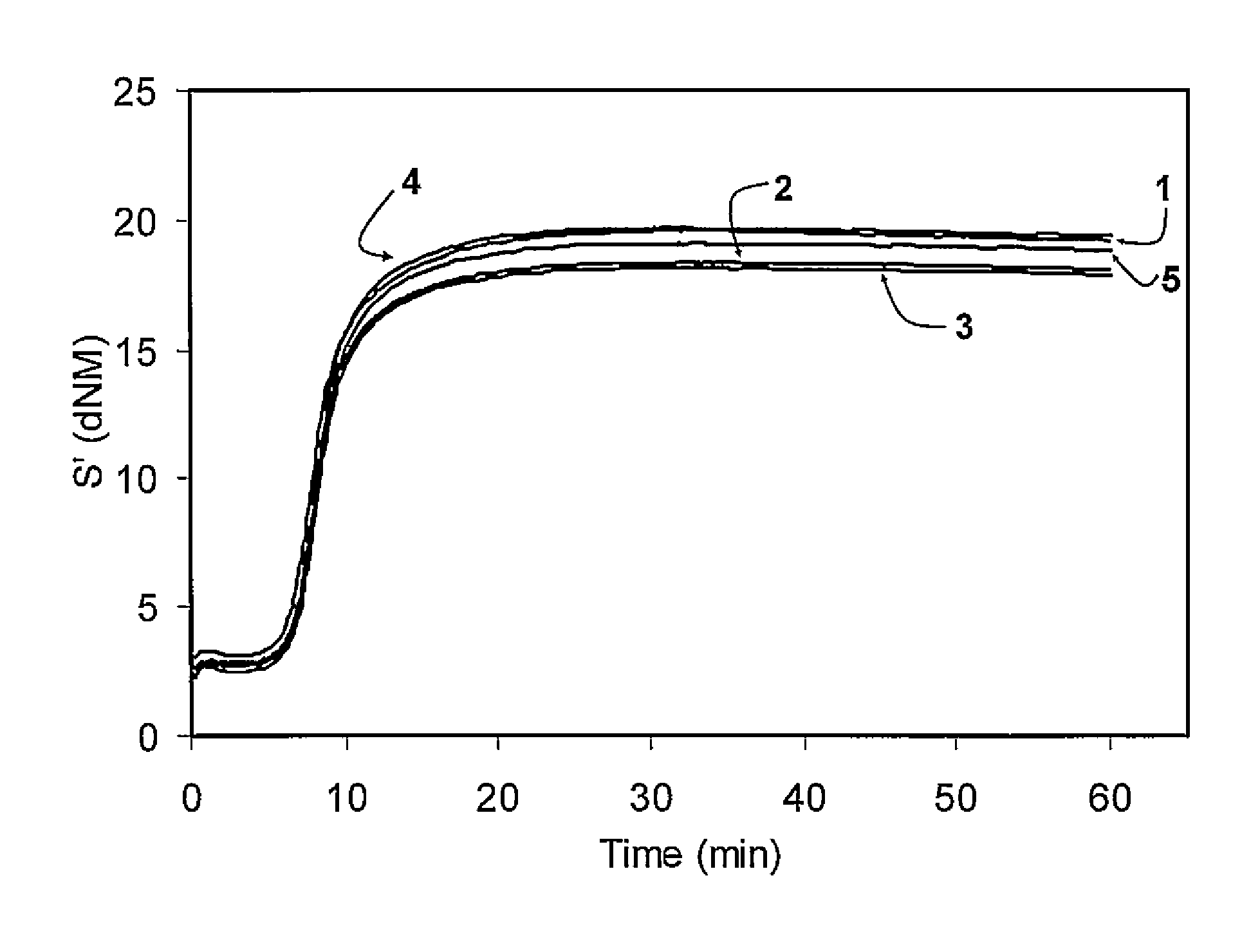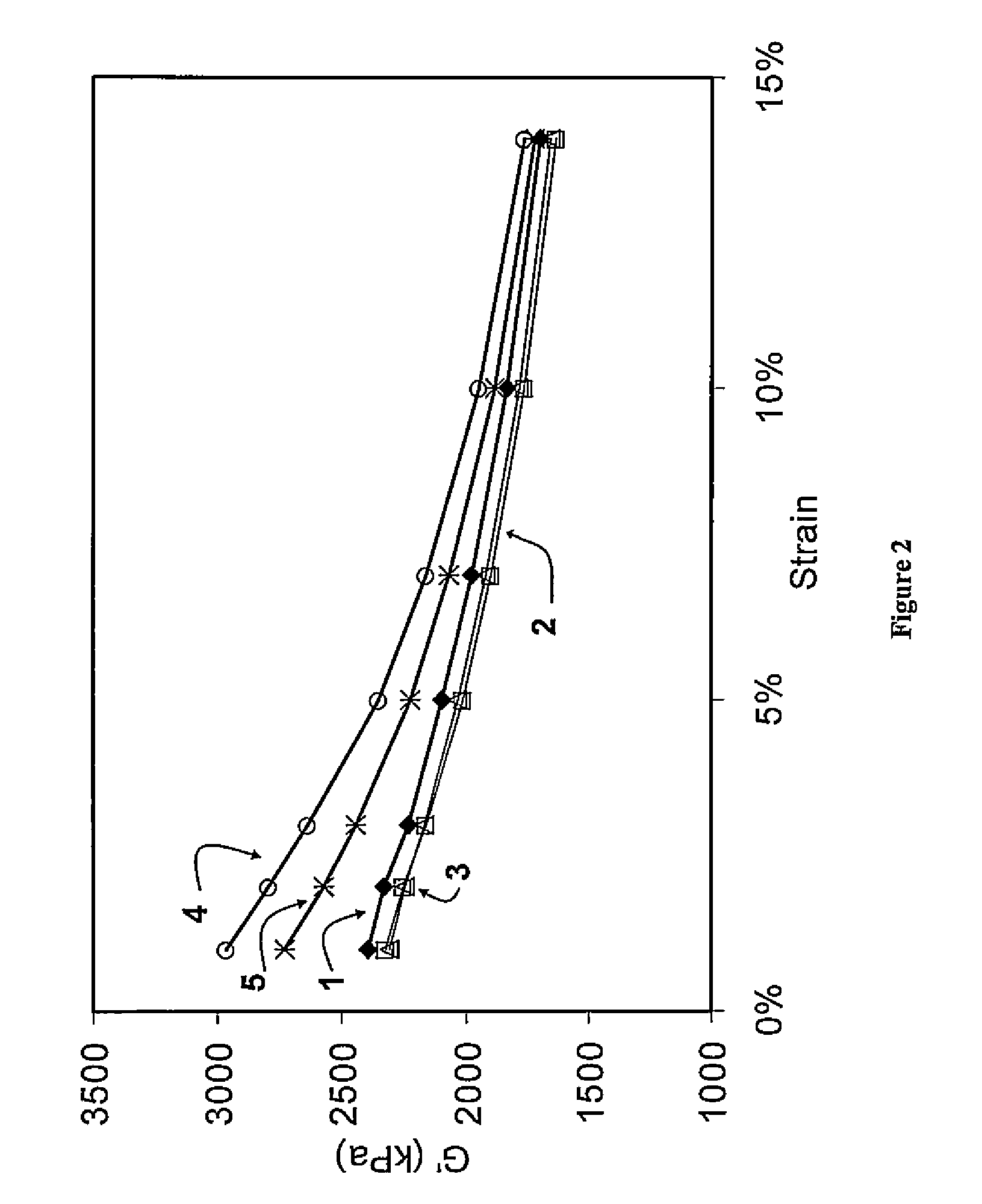Functionalized polymer, rubber composition and pneumatic tire
a technology of functionalized polymers and rubber compositions, applied in the field of functionalized polymers, can solve the problems of low polymer hysteresis and provide a lower level of tire rolling resistance, and achieve the effects of improving the affinity of fillers, improving the interaction of polymer/filler, and low cos
- Summary
- Abstract
- Description
- Claims
- Application Information
AI Technical Summary
Benefits of technology
Problems solved by technology
Method used
Image
Examples
example 1
[0075]Trisoprpanolamine (253.0 g, from Aldrich), tetraethylsilicate (289 g, from Aldrich) and potassium hydroxide (3.7 g, form Aldrich) were mixed in a 1-liter 3-neck round bottle flask equipped with distillation apparatus. The mixture was then heated to 85° C. by heating mantle, and ethanol produced from the reaction was removed under reduced pressure of 200 mmHg. After 2 hour of reaction the pressure was set to 100 mmHg, and the mixture was heated to 120° C. for an additional hour. Total of 230 mL of ethanol was recovered from the distillation. The oily crude product was then distilled out under the pressure of ˜2 mmHg and the temperature of 120° C. Total of 305 g (88.2% yield) of white crystalline solid, 1-ethoxy-3,7,10-trimethylsilatrane (ESTI), was obtained. 1HNMR and 13CNMR spectroscopy analysis has shown larger than 95% purity of the desired product. m.p. 80-83° C.
example 2
[0076]Trisoprpanolamine (253.0 g), (3-chloropropyl)triethoxysilane (326.5 g, from Aldrich) and potassium hydroxide (2.1 g) were mixed in a 1-liter 3-neck round bottle flask equipped with distillation apparatus. The mixture was then heated to 90° C. by heating mantle, and ethanol produced from the reaction was removed under reduced pressure of 350 mmHg. After 2 hour of reaction the pressure was reduced to 150 mmHg for 1 hour, then 100 mmHg for another hour. Total of 213 mL of ethanol was recovered from the distillation. The oily crude product was then distilled out under the pressure of ˜3 mmHg and the temperature of 160° C. Total of 364 g (98.2% yield) of clear oily liquid, 1-(3-chloropropyl)-3,7,10-trimethylsilatrane (CSTI), was obtained. 1HNMR and 13CNMR spectroscopy analysis has shown larger than 95% purity of the desired product.
example 3
[0077]Trisoprpanolamine (250.9 g), isobutyltriethoxysilane (294.9 g, from Aldrich) and potassium hydroxide (3.7 g) were mixed in a 1-liter 3-neck round bottle flask equipped with distillation apparatus. The mixture was then heated to 100° C. by heating mantle, and ethanol produced from the reaction was removed under reduced pressure of 400 mmHg. After 2 hour of reaction the pressure was reduced to 200 mmHg for 1 hour, then 100 mmHg for another hour. Total of 223 mL of ethanol was recovered from the distillation. The oily crude product was then distilled out under the pressure of ˜4 mmHg and the temperature of 140° C. Total of 336 g (93.7% yield) of clear oily liquid, 1-isobutyl-3,7,10-trimethylsilatrane (BSTI), was obtained. 1HNMR and 13CNMR spectroscopy analysis has shown larger than 95% purity of the desired product.
PUM
| Property | Measurement | Unit |
|---|---|---|
| particle diameter | aaaaa | aaaaa |
| temperatures | aaaaa | aaaaa |
| temperatures | aaaaa | aaaaa |
Abstract
Description
Claims
Application Information
 Login to View More
Login to View More - R&D
- Intellectual Property
- Life Sciences
- Materials
- Tech Scout
- Unparalleled Data Quality
- Higher Quality Content
- 60% Fewer Hallucinations
Browse by: Latest US Patents, China's latest patents, Technical Efficacy Thesaurus, Application Domain, Technology Topic, Popular Technical Reports.
© 2025 PatSnap. All rights reserved.Legal|Privacy policy|Modern Slavery Act Transparency Statement|Sitemap|About US| Contact US: help@patsnap.com



